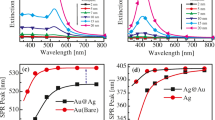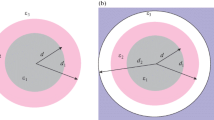Abstract
Core–shell structures exhibit excellent versatility, tunability, and stability due to the different material compositions. Here, we synthesized the core–shell structure (SiO2@Au) by sol–gel method and measured the scattering spectra of its monomer, dimer, and trimer by dark field technique. Meanwhile, the contribution of multipole moments to the scattering cross-section is discussed by Mie theory. The simulated total scattering cross-section mainly contributed by electric dipole moments is in good agreement with the experimental spectra. We also found that the inner surface charge of gold shells changes significantly at different wavelengths of linearly polarized light as well as at different circularly polarized light. The asymmetric trimer with a core–shell structure has a more significant chiral response than the gold trimer. Meanwhile, there is a significant electric field enhancement at the slit between particles. This is especially useful for surface-enhanced Raman spectroscopy and the detection of trace chiral molecules.





Similar content being viewed by others
Data Availability
The data that support the findings of this study are available from the corresponding author upon reasonable request.
References
Li JF, Zhang YJ, Ding SY, Panneerselvam R, Tian ZQ (2017) Core-shell nanoparticle-enhanced Raman spectroscopy. Chem Rev 117(7):5002–5069
Schultz J, Kirner F, Potapov P, Büchner B, Lubk A, Sturm EVn (2021) Tailoring plasmonics of Au@Ag nanoparticles by silica encapsulation. Adv Optical Mater 9(22)
Pol VG, Srivastava DN, Palchik O, Palchik V, Slifkin MA, Weiss AM, Gedanken A (2002) Sonochemical deposition of silver nanoparticles on silica spheres. Langmuir 18(8):3352–3357
Stöber W, Fink A, Bohn E (1968) Controlled growth of monodisperse silica spheres in the micron size range. J Colloid Interface Sci 26(1):62–69
Lu Y, Yin Y, Li ZY, **a Y (2002) Synthesis and self-assembly of Au@SiO2 core−shell colloids. Nano Lett 2(7):785–788
Srnová-Šloufová I (2000) František Lednický, Antonín Gemperle, Juliana Gemperlová, Core−shell (Ag)Au bimetallic nanoparticles: analysis of transmission electron microscopy images. Langmuir 16(25):9928–9935
Zhang C, Zhang T, Zhang Z, Zheng H (2019) Plasmon enhanced fluorescence and Raman scattering by [Au-Ag alloy NP cluster]@SiO(2) core-shell nanostructure. Front Chem 7:647
Nagarajan A, Panchanathan AP, Chelliah P, Satoh H, Inokawa H (2022) FDTD Study on evolution of trimer silver@silica nanospheres to dimer for SERS characteristics. Plasmonics 17(2):647–652
Lu F, Tian Y, Liu M, Su D, Zhang H, Govorov AO, Gang O (2013) Discrete nanocubes as plasmonic reporters of molecular chirality. Nano Lett 13(7):3145–3151
Guo Y, Zhu G, Fang Y (2021) Plasmon–exciton coupling between plasmons and chiral molecules in core–shell structure under circularly polarized light excitation. J Appl Phys 129(4)
Wy Y, Lee S, Wi DH, Han SW (2018) Colloidal clusters of bimetallic core-shell nanoparticles for enhanced sensing of hydrogen in aqueous solution. Part Part Syst Charact 35(5)
Guntner AT, Schenk FM (2023) Environmental formaldehyde sensing at room temperature by smartphone-assisted and wearable plasmonic nanohybrids. Nanoscale 15(8):3967–3977
Chaâbani W, Proust J, Ouellet S, Movsesyan A, Béal J, Bachelot R, Xu T, Baudrion A-L, Adam P-M, Boudreau D, Chehaidar A, Plain J (2021) Si@Au core–shell nanostructures: toward a new platform for controlling optical properties at the nanoscale. The Journal of Physical Chemistry C 125(37):20606–20616
Lee S, Hwang H, Lee W, Schebarchov D, Wy Y, Grand J, Auguié B, Wi DH, Cortés E, Han SW (2020) Core–shell bimetallic nanoparticle trimers for efficient light-to-chemical energy conversion. ACS Energy Lett 5(12):3881–3890
Li Z, Käll M, Xu H (2008) Optical forces on interacting plasmonic nanoparticles in a focused Gaussian beam. Physical Rev B 77(8)
Chen Y, Wu H, Li Z, Wang P, Yang L, Fang Y (2012) The study of surface plasmon in Au/Ag core/shell compound nanoparticles. Plasmonics 7(3):509–513
Prodan E, Radloff C, Halas N, Nordlander P (2003) A hybridization model for the plasmon response of complex nanostructures. Science (American Association for the Advancement of Science) 302(5644):419–422
Graf C (2002) Alfons Van Blaaderen, Metallodielectric colloidal core−shell particles for photonic applications. Langmuir 18(2):524–534
Dali Shao HS (2012) Mingpeng Yu, Jie Lian, and Shayla Sawyer, Enhanced ultraviolet emission from poly(vinyl alcohol) ZnO nanoparticles using a SiO2−Au core/shell structure. Nano Lett 12(11):5840–5844
Chen H, Sun Z, Ni W, Woo KC, Lin HQ, Sun L, Yan C, Wang J (2009) Plasmon coupling in clusters composed of two-dimensionally ordered gold nanocubes. Small 5(18):2111–2119
Guan Z, Gao N, Jiang XF, Yuan P, Han F, Xu QH (2013) Huge enhancement in two-photon photoluminescence of Au nanoparticle clusters revealed by single-particle spectroscopy. J Am Chem Soc 135(19):7272–7277
Sinzig J, Quinten M (1994) Scattering and absorption by spherical multilayer particles. Appl Phys Solid Surf 58(2):157–162
Inoue M, Ohtaka K (1983) Surface enhanced Raman scattering by metal spheres. I:Cluster Effect. J Phys Soc Jpn 52(11):3853–3864
Mühlig S, Menzel C, Rockstuhl C, Lederer F (2011) Multipole analysis of meta-atoms. Metamaterials 5(2):64–73
Ibrahim O, Lee S, Kim SW, Pyun SB, Woods C, Cho EC, Park S-J, Fakhraai Z (2021) Optical magnetic multipolar resonances in large dynamic metamolecules. J Phys Chem C 125(30):16605–16619
Grahn P, Shevchenko A, Kaivola M (2012) Electromagnetic multipole theory for optical nanomaterials. New J Phys 14(9):93033
Johnson PB, Christy RW (1972) Optical constants of the noble metals. Phys Rev B 6(12):4370–4379
Hu L, Huang Y, Fang L, Chen G, Wei H, Fang Y (2015) Fano resonance assisting plasmonic circular dichroism from nanorice heterodimers for extrinsic chirality. Sci Rep 5(1):16069
Tian X, Sun S, Leong ESP, Zhu G, Teng J, Zhang B, Fang Y, Ni W, Zhang CY (2020) Fano-like chiroptical response in plasmonic heterodimer nanostructures. Phys Chem Chem Phys 22(6):3604–3610
Yin X, Schäferling M, Metzger B, Giessen H (2013) Interpreting chiral nanophotonic spectra: the plasmonic Born-Kuhn model. Nano Lett 13(12):6238–6243
Zhu G, Sun Z, Liu J, Fang Y (2023) Multipole analysis of the extinction cross section and circular dichroism of chiral metamolecules with optical theorem. Advanced Optical Materials 11(9):2202677
Lu Y, Yao G, Sun K, Huang Q (2015) β-Cyclodextrin coated SiO2@Au@Ag core–shell nanoparticles for SERS detection of PCBs. Phys Chem Chem Phys 17(33):21149–21157
Funding
This research was supported by the National Natural Science Foundation of China (NSFC) (Grant No. 12074054, 12274054).
Author information
Authors and Affiliations
Contributions
Y.F. directed the project. J.L. did the simulations and analyzed the simulation data. R.Y. did the experiment and analyzed the experimental data. N.G. and Y.C. discussed the results and analysis. J.L. and R.Y. wrote the manuscript. All of the authors revised the manuscript.
Corresponding author
Ethics declarations
Conflict of Interest
The authors declare no competing interests.
Additional information
Publisher's Note
Springer Nature remains neutral with regard to jurisdictional claims in published maps and institutional affiliations.
Rights and permissions
Springer Nature or its licensor (e.g. a society or other partner) holds exclusive rights to this article under a publishing agreement with the author(s) or other rightsholder(s); author self-archiving of the accepted manuscript version of this article is solely governed by the terms of such publishing agreement and applicable law.
About this article
Cite this article
Liu, J., Yan, R., Gao, N. et al. The Multipolar Contribution and Plasmon Hybridization in Core–Shell Clusters. Plasmonics (2024). https://doi.org/10.1007/s11468-023-02186-0
Received:
Accepted:
Published:
DOI: https://doi.org/10.1007/s11468-023-02186-0




